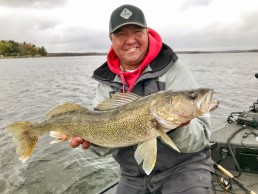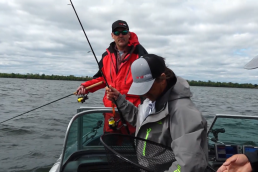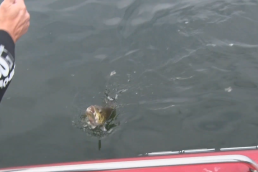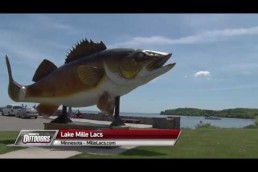Tony Roach’s May Mille Lacs Walleye Forecast
SHARE THIS POST
For a timely forecast on the upcoming Minnesota walleye fishing opener on 132,000-acre Lake Mille Lacs, we caught up with MidWest Outdoors contributor and Minnesota fishing guide Tony Roach. He fishes this noted walleye and smallmouth bass factory in all seasons, so he is tuned in to the pulse of the fishery and what it can offer anglers who visit there this month.
MidWest Outdoors: With an early ice-out again this year, we can expect the post-spawn period to be a little ahead of schedule as far as walleye location and behavior. Talk about your expectations for fishing success this month.
Tony Roach: Whether it’s fall or springtime, I absolutely love pitching baits in shallow water for walleyes. I cherish the month of May because fishing with jigs and shiners or jigs and plastics this time of year, or casting jerkbaits, and fishing in less than 10 feet of water, is so productive. But it’s also a time of transition, with gamefish on the move, so you have to be able to adjust your presentations to stay on the hot bite. With the early spring this year, that transition is going to accelerate.
MWO: Specifically, what does the transition entail, and how can we adapt as anglers to keep catching these walleyes on the move?
Roach: Mille Lacs is a beautiful lake in terms of the incredible structure and all the different locations that can hold walleyes, especially in May and early June. There are miles of sand, gravel and rock shorelines, lots of shallow rock reefs close to shore, and the secondary breakline from the 10- to 15-foot range is also a fish magnet as waters warm.
You have to pay attention to where you get bites on any given day in May. Walleyes will relocate throughout the day, depending on light penetration and especially windy conditions or changes in the weather. Often in May, you’ll see the fish slide in and out of the shallows with changing conditions, or just time of day. Fish are shallower at morning and evening a lot of times, and if it’s a calm day, they’ll slide to 14 feet; but if the wind picks up, you’ll be catching them in less than 10, and even 6 feet or less. It’s incredible to me how much those walleyes move in spring, compared to the summer locations where they set up day-in and day-out.
MWO: From after the spawn right through summer to the fall bite, the primary driver for walleye location on any fishery is going to be food. Walleyes will always be near available food sources. How does that influence them on Lake Mille Lacs?
Roach: By around Memorial Day Weekend, we start to get the bug hatches on Mille Lacs. Some insects hatch from rock and gravel bars, but the main bug hatches are from the mud basin. You’ll see entire populations of walleyes that were keying on baitfish in shallow water shift their locations to the mudflats to feed on bugs, as well as chase the baitfish that also are attracted to these hatches. It’s always amazing to be catching walleyes consistently in less than 10 feet of water, and then an uptick in water temps happens and there’s a big hatch, and those shallow areas will be completely devoid of fish almost instantly.
Then you find them again in 15 to 20 feet, where a lot of the hard-bottom shoreline areas transition to the mud basin, plus fish load up on the closer mudflats (meaning mudflats closer to shorelines compared to flats in the center of the lake). The 25- to 30-foot gravel bars start loading up with fish, the deep edges of the rock reefs start producing, and you see the dispersal of those shallow walleyes to deeper structure.
MWO: Give advice to anglers who maybe haven’t fished the lake before—or it’s their first trip of the season to Mille Lacs. How do you narrow down where to fish right out of the gate?
Are you enjoying this post?
You can be among the first to get the latest info on where to go, what to use and how to use it!
Roach: In May, you can mostly focus on less than 20 feet of water and contact fish, but as I’ve already said, pay attention to wind direction, water temps, and if there a bug hatch going on. You have to be versatile. Another thing: Electronics are key on Mille Lacs, and the beauty is, you’re not fishing areas with vegetation, so it’s really easy to graph fish. You can easily spot the walleyes because they are on sand, rock, gravel or mud structure, for the most part.
I always start out by cruising spots and learning where the fish are, based on what I see on my Lowrance units. If you have side imaging or “live” technology, so much the better. In May, start by running those shoreline breaks to determine if you have walleyes holding in 10 to 14 feet of water. Pay attention to conditions, too. Is it really overcast? Fish will be even shallower. Wind blowing hard? Focus on the windward side of the lake.
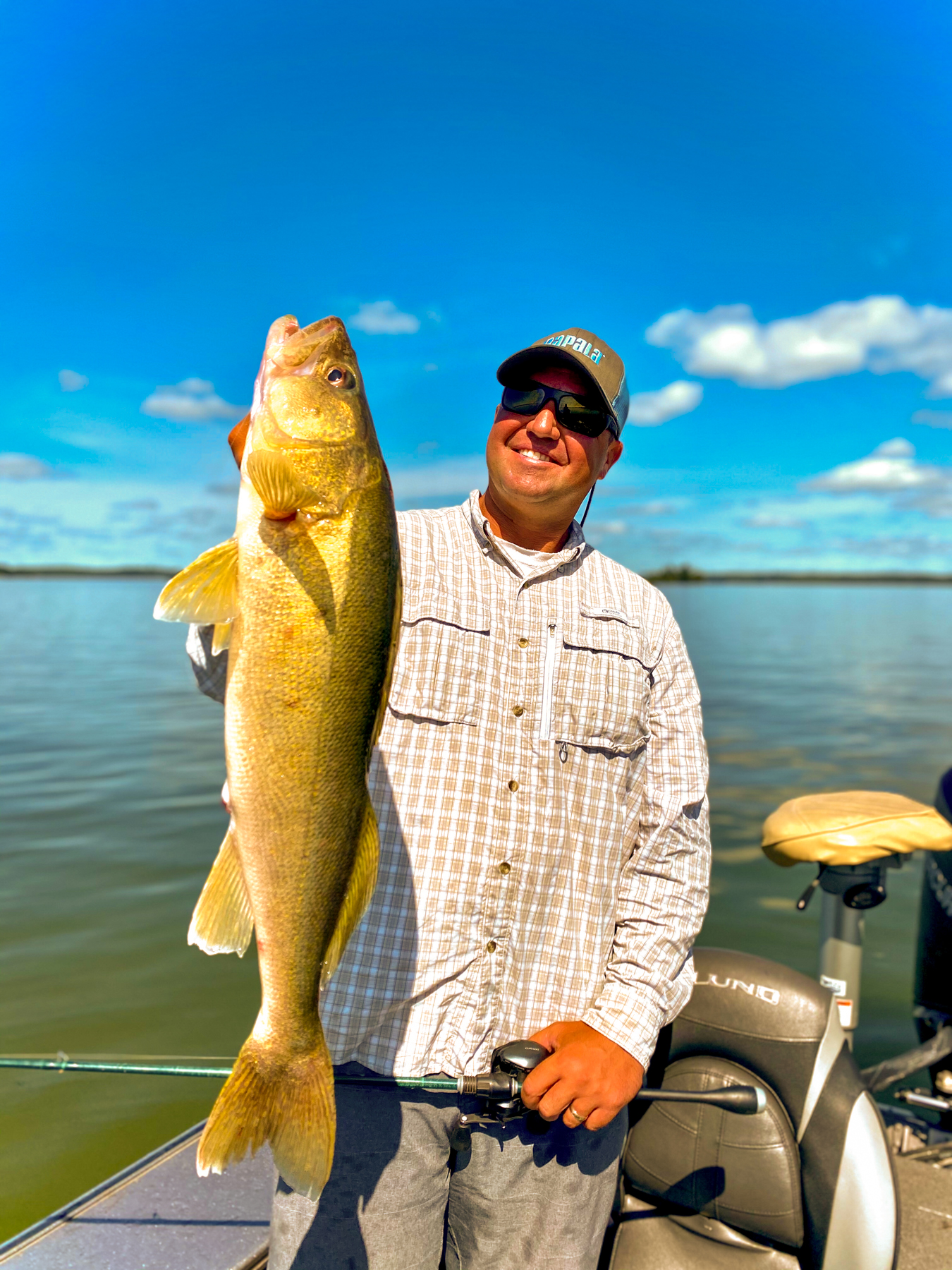
MWO: Break down your techniques for catching walleyes in May on Mille Lacs.
Roach: This year in particular, you’re going to see more wind-driven walleyes, just because of the huge amount of perch minnows in Lake Mille Lacs right now. Predators will be set up on structure, in ambush positions. The lake’s going to fish a lot more like your classic midwestern walleye lakes, where you mostly have to play the wind.
I’ll be fishing in May with a 1/4- or 1/8-ounce VMC MoonEye Jig. I like the aspirin-head design because it falls more slowly in the water column than a traditional round head jig. Plus, if I’m fishing with plastics, it holds a 3-inch soft-body lure like a Storm Large Shad really well.
As far as whether I choose shiner minnows or a Largo Shad, I use water temperature as my guide. If the water is in the 40s to low 50s, it’s mostly a shiner for bait; but once water temps hit the mid-50s I’ll throw a jig-and-plastic a lot more. Jerkbaits like a #10 X-Rap also are big producers for me when temps reach those levels.
Another variable is how aggressively I fish the bait. As a rule, you can’t snap a jig/minnow combo as much because you’ll lose the bait. But even with plastics, if the water is colder, I fish much more slowly…almost dragging the jig across the bottom. A little “drag-pop, drag-pop” and let it lay on the bottom. A lot of bites come when it’s at rest on the bottom.
With mid-50s water temps, I’ll snap the jig a lot more aggressively. Same with the X-Rap. Fish it a lot slower, with really long pauses, with low 50s temps. When the water gets to the high 50s to low 60s, I can fish a jerkbait or a Largo Shad super aggressively—and the jerkbait even more so. Both are great tools to cover a lot of water pretty quickly and determine where those schools of walleyes are holding. But when you’re getting bit on the jerkbait, you can make long casts, fish fast and eliminate a lot of water. Then you can slow down and fish a jig when you locate numbers of fish.
I spool up with either 6- or 10-pound-test Sufix 832 braid plus a 10-pound Sufix Advance Fluorocarbon leader, because of the abrasion resistance of fluoro to combat all the zebra mussels in the lake. If you fish with mono, your line gets too nicked up and you break off way too many fish. Pair these combos up with a 6’8”, 6’10” or 7’0,” medium-power St. Croix spinning rod with an extra-fast action. The extra-fast action is key to feel your way along the bottom, and that action loads perfectly when you do get bit.
MWO: Awesome info, Tony! Thanks for sharing so many details. We’ll see you out on Lake Mille Lacs in May!
MWO
SHARE THIS POST
Did you enjoy this post?
You can be among the first to get the latest info on where to go, what to use and how to use it!
